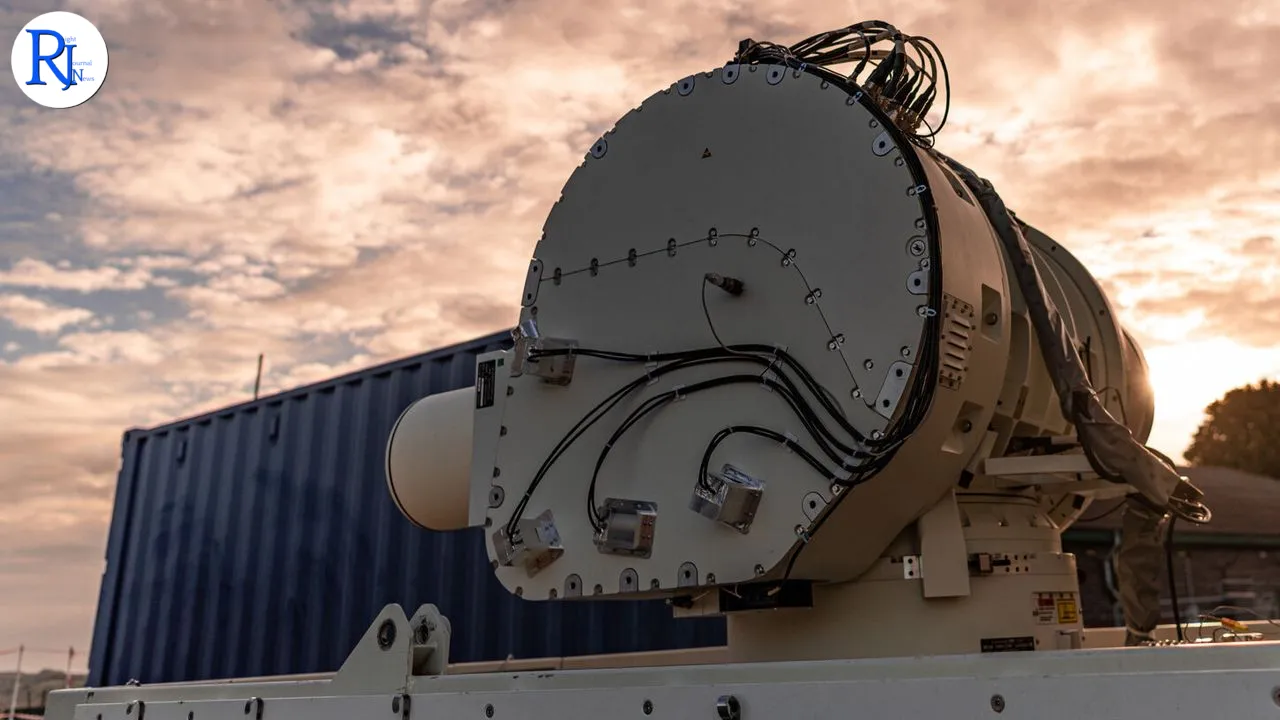Britain’s DragonFire laser weapon has taken a decisive step toward frontline use, according to a new report. The laser directed energy weapon, developed for the UK Ministry of Defence, can hit a coin-sized target from a kilometre away and engage drones flying at up to 400 mph. The programme now runs five years ahead of its original deployment plan, the report states, signalling a major shift in how the UK could counter fast, agile threats in the air and at sea. Defence officials and industry partners see DragonFire as a way to cut the cost of air defence while improving precision and reducing collateral damage. The latest trials underline that promise and point to faster adoption across the services.
TechRadar reported the new results on 25 November 2025. The UK has trialled DragonFire at government ranges in recent years as part of a Ministry of Defence push to move directed energy weapons from lab benches to operational units. Earlier high-power firings took place at the MOD Hebrides Range off Scotland, where the programme demonstrated accurate, long-range tracking and engagement against representative aerial targets.

Image Courtesy of Tech Radar
Precision at range: coin-sized accuracy changes the calculus
DragonFire’s ability to hold a steady beam on a small target at one kilometre matters for two reasons. First, precision turns power into effect. A laser does not rely on explosive warheads; it needs to keep energy focused on a small spot long enough to disable sensors, control surfaces, or structures. Hitting a coin-sized area at distance indicates tight beam control and high-quality tracking, the core of any effective laser weapon.
Second, accuracy reduces unintended damage. Unlike shrapnel-producing munitions, a laser delivers energy only where the beam lands. That reduces risk around ports, airfields, or urban areas, where air defence engagements can pose hazards. UK officials have previously framed DragonFire as a tool that can neutralise threats at lower cost and with greater control than missiles, and the latest performance claims align with that aim.
From lab to field: five-year acceleration signals urgency
The reported five-year acceleration marks a notable shift in tempo. Defence officials started the DragonFire effort as a technology demonstrator led by the Defence Science and Technology Laboratory (Dstl) with industry partners. Over the past two years, ministers and commanders have pushed to bring the technology to sea and land platforms sooner, citing the rise of low-cost drones and cruise missiles.
An acceleration on this scale usually reflects both technical progress and operational pressure. The UK, like allies, has watched conflicts where drones and loitering munitions strain air defence stockpiles and budgets. Moving DragonFire up the timeline suggests the programme team now sees a path to fielding a usable capability earlier than planned, while continuing to mature power, cooling, safety, and rules-of-engagement frameworks.
Countering speed: trials against 400mph drones
TechRadar reports that DragonFire engaged drones flying at up to 400 mph during the latest trials. That speed sits in the range of some jet-powered target drones and fast cruise missile surrogates, and it far exceeds the pace of most small quadcopters. Tracking and heating a fast target demands rapid sensors, stable pointing, and software that predicts motion and jitter.
Fast-drone performance matters because air defenders face a mixed threat set. Forces must counter cheap, slow drones that arrive in swarms and tougher, faster targets that demand quick reaction. A laser that can handle both types can fill gaps alongside guns and missiles. It can take on close-in tasks that might otherwise consume expensive interceptors, freeing those missiles for the hardest shots.
Cost and sustainability: pounds-per-shot reshape defence economics
Directed energy weapons change the arithmetic of air defence. Missiles remain essential, but they cost hundreds of thousands of pounds or more per shot and require complex supply chains. By contrast, DragonFire draws power from the platform. UK officials have previously said a shot from the demonstrator costs only a small fraction of a missile, often cited in the low tens of pounds. That cost profile allows commanders to engage more targets more often without draining magazines or budgets.
Sustainability extends beyond money. A laser offers a deep magazine limited mainly by power and cooling. On a warship with robust generators, or a land vehicle with dedicated power modules, DragonFire can fire repeatedly, assuming suitable line-of-sight and weather. That persistence supports defence against saturation attacks, where adversaries try to overwhelm a site with numbers.
Industry partnership: MBDA, Leonardo and QinetiQ drive the build
DragonFire brings together a UK industry team. MBDA UK leads weapon system integration and command and control. Leonardo contributes the beam director and electro-optic tracking, crucial for placing and holding the laser on target. QinetiQ provides the high-power laser source. Dstl manages the programme for the Ministry of Defence, funding trials and linking the technology to user needs.
That shared approach spreads risk and draws on specialised expertise. It also positions the UK to retain sovereign control over critical components and export decisions. As the programme moves from demonstration to early capability, the team will need to package the system for ships and land platforms, harden it for operational environments, and scale manufacturing.
Limits and lessons: weather, safety and rules of engagement
No laser provides a cure-all. Fog, rain, smoke and dust can scatter or absorb energy, which reduces range and effect. Mirage-like distortions in hot air can complicate pointing. Programme engineers address these problems with sensors, software and adaptive optics, but commanders still need traditional guns and missiles to ensure all-weather defence.
Safety and policy also matter. A high-energy beam travels at the speed of light and can pose risks to friendly aircraft or satellites if planners do not control firing windows and aim points. The services must build robust rules of engagement, clear communications with airspace controllers, and training that blends lasers into layered defence plans. Early at-sea and on-land trials will validate those procedures.
Where it fits: ships, airfields and expeditionary units
If the programme continues to advance, DragonFire looks most at home on platforms with power and cooling capacity. Warships provide that, and they face a rising threat from drones, fast boats and cruise missiles, especially in congested seas. A ship-mounted laser can support close-in defence and free up missiles for long-range shots.
On land, air bases, critical infrastructure and expeditionary units can benefit from a layered defence that includes lasers for short-range, high-volume threats. Integrators will need to package the system for mobility, protect it from dust and shock, and tie it into radar and command networks. The UK’s existing air defence architecture provides a backbone for that integration.
What happens next: trials, integration and allied interest
The reported performance and schedule jump point to a busy next phase. Expect more trials that stress the system in varied weather, against different targets and with military crews at the controls. The team will likely test power modules, cooling loops and combat system interfaces that match ship and land platforms.
Allies will watch closely. Many NATO nations run laser programmes, and they share lessons on power scaling, beam quality and safety. DragonFire’s progress could spur collaboration or parallel buys, especially if the UK can demonstrate reliable performance at sea and deliverable logistics on land.
The UK’s DragonFire programme now stands at a promising inflection point. With coin-sized accuracy at a kilometre and engagement of drones at 400 mph reported, the system shows the precision and responsiveness that modern air defence needs. A five-year acceleration underscores urgency and confidence. Work remains on weather resilience, integration and doctrine, but the direction looks clear: lasers will sit alongside missiles and guns in British layered defence. If trials continue to deliver, commanders could soon field a cost-effective tool to counter swarming drones and fast-moving threats, easing pressure on missile inventories and strengthening protection for ships, airfields and key sites.

